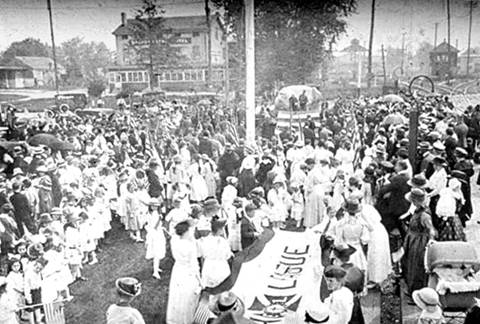
Jericho was settled by Europeans in the mid 17th century. To its south, the empty plain saw no settlement for two centuries, although it was crisscrossed by many merchants and other travelers, who went back and forth between the settlements on the North and South Shores. The hooves of the travelers' horses, and the wheels of their wagons, slowly carved roads across the plain. Before one of the southbound roads got too far from Jericho, it forked in three, with each of its fork's tines heading off to a different South Shore settlement.
No one saw fit to permanently settle at the forks until the 1830s, and even then settlement came about because of a quirk - the new railroad had run out of money, and thus could not build further east. It constructed a little depot where things had stopped, and railroad president Valentine Hicks dubbed the place "Hicksville." The depot's access to New York City and its markets soon attracted people to the area, and a village took root.
Just north of that depot, the diverging of the roads to Jerusalem and South Oyster Bay (i.e., today's Wantagh and Massapequa, respectively) created a triangular plot of land. In time, this triangle would become a focal point for the village. Situated on it, or across the road from it, would be resort hotels, and the homes of some of the village's prominent families, with names like Augustin and Fassbender.

The Triangle, seen looking south from John Street; date uncertain
Like the 1939 view used at the start of this article, this image is one of
the Hicksville Public Library Digital Images at https://nyheritage.org
(digitally modified / "restored" by the author)
Eventually, the Triangle would become a venue for speeches, holiday celebrations, band concerts, and even the posting of campaign results on an election-night. On the first Memorial Day after the Great War, many hundreds of people paraded to it, in celebration of the return of those who had gone off in uniform. For each of the three men who would never return, they planted a young oak. Hicksvillians expected that for decades, perhaps even longer, while the trees grew tall and strong, they would help keep alive the memories of the sacrifices made by those three men. On the following July Fourth, the village unveiled and dedicated a war monument near those young oaks - an enduring boulder that already had withstood eons, which proudly bore a plaque with the names of all those who had served.

Depot Square, probably on July 4, 1919, when the War Monument
(behind the dais, near the flagpole) was unveiled and dedicated
Hicksville Public Library Digital Images at https://nyheritage.org
(digitally modified / "restored" by the author)
Note: The Epworth League - the women holding the banner in the
foreground - was a predecessor of Methodist Youth Fellowship.
All in all, the Triangle (including Depot Square, the name given to the open area at its southern edge) was a worthy little "town square" - but things change.
***

